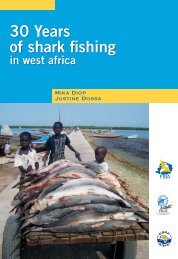Kyne & Simpfendorfer.. - Shark Specialist Group
Kyne & Simpfendorfer.. - Shark Specialist Group
Kyne & Simpfendorfer.. - Shark Specialist Group
You also want an ePaper? Increase the reach of your titles
YUMPU automatically turns print PDFs into web optimized ePapers that Google loves.
Leucoraja circularis, blonde skate Raja brachyura, thornback skate R. clavata, clearnose<br />
skate R. eglanteria, brown skate R. miraletus and rough skate R. radula.<br />
Some particular species which require justification as to their absence from this report are the<br />
broadnose sevengill shark Notorynchus cepedianus, which although recorded to 570m is<br />
primarily a coastal inshore shark of temperate waters; the spiny or piked dogfish Squalus<br />
acanthias, primarily a shelf species, but which occurs occasionally on the slope and<br />
exceptionally to 1446m; the Sparsetooth dogfish Scymnodalatias oligodon and the Largetooth<br />
cookiecutter shark Isistius plutodus, although both occur over very deep water (to 4000m),<br />
they have both only ever been recorded in the epipelagic zone (0-200m depth in the water<br />
column) (it should be noted though that these species are potential vertical migrators and may<br />
also occur in the mesopelagic and bathypelagic zones); the megamouth shark Megachasma<br />
pelagios, a coastal, shelf and epipelagic species recorded from the pelagic zone to depths of<br />
166m over water to 4600m depth, but never recorded from deep water. One last notable<br />
species is the great white shark Carcharodon carcharias, a coastal, inshore, shelf and<br />
epipelagic offshore species known to undertake considerable migrations. Great whites have<br />
rarely been recorded from the continental slope (Compagno 2001), and thus in deepwater, and<br />
a reported capture at 1280m (Bigelow and Schroeder 1948a, Compagno 2001) is doubtful<br />
(Bonfil et al. 2005). However, more recent research of a shark tagged off South Africa has<br />
shown that during transoceanic migration great whites undertake periodic deep dives to<br />
depths of up to 980m (Bonfil et al. 2005). It should be noted that this depth is the sensor limit<br />
for the tag employed and so it is possible that the tagged shark dived to depths in excess of<br />
980m. While deep dives were regular in occurrence during its migration, with the shark<br />
spending 18% of the time at depths of 500-750m, a far greater amount of time (61%) was<br />
spent at the surface in water 0-0.5m deep (Bonfil et al. 2005). Thus, given the species'<br />
primarily coastal and epipelagic occurrence, it is not further discussed here.<br />
AIMS OF THE PROJECT<br />
The overall aim of the present study is to provide a collation and summarization of the<br />
available information and data on the biodiversity, life history and fisheries of deepwater<br />
chondrichthyan fishes at the global level.<br />
By examining the present status of knowledge, the project will also address the specific data<br />
needs required to provide a global understanding of the vulnerability of deepwater<br />
chondrichthyans to fisheries, and to provide a baseline from which to prioritize research,<br />
conservation and management. To address the central aim, the report is divided into three<br />
Sections. Section I reviews the global biodiversity of deepwater chondrichthyans and<br />
provides a checklist of all known living, described and undescribed deepwater species. This<br />
annotated checklist incorporates a summary of the known distribution, habitat and depth<br />
occurrence of each species, as well as any taxonomic notes where relevant. Section II collates<br />
available (published and unpublished) information on life history and provides relevant<br />
summaries of biological data including a demographic assessment of the productivity of<br />
deepwater chondrichthyans. Section III summarizes global and regional catch data for<br />
deepwater chondrichthyans. Regional and fisheries case-studies are presented to illustrate<br />
specific examples of catch trends, management or monitoring information.<br />
9
















